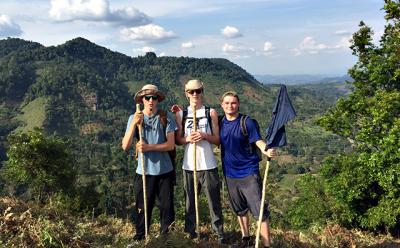Students Learn Life Lessons in Nicaragua

Irene Hatgistavrou wasn’t sure exactly what to expect when she boarded an airplane — then a bus, then another bus, then an off-road vehicle — on her way to a rural village in Nicaragua, where a group of East Hampton High School student volunteers were headed on a trip through the nonprofit organization BuildOn. Their mission was to build a school alongside the villagers of Cabecera del Cano, a place about 20 miles from Honduras that Google maps couldn’t even find.
But Irene, a senior, knew one thing for certain. “I do a lot of volunteer work, but nothing like this,” she said. “I wanted to go on the BuildOn trip because I wanted to experience what it was like to go to a remote village. I wanted to see how others live.”
That was one of the goals of the trip, according to Billy Barbour, a social studies teacher who is the coordinator of the high school’s BuildOn club. The club is an offshoot of the nonprofit organization, which partners with schools across the U.S. to build schools in developing nations around the world.
Last spring, East Hampton’s BuildOn club traveled to Nepal, and the previous year, before it was an official high school club, a group of students traveled with BuildOn to Senegal. The 15 students who traveled to Nicaragua during this year’s spring break in April didn’t just build the foundation of a school, they built relationships with the villagers and gained cultural understanding.
“The biggest thing they get is perspective,” Mr. Barbour said. “The consistent theme is being grateful and having perspective on what is actually important. The villagers have very little, but they are happy, spend so much time with their family and friends, and are so open and warm. And our kids get this sense of self-worth because they are doing this important thing.”
While in Nicaragua, Irene observed differences between men and women in the village, such as the women’s hesitation to take on the same physically challenging tasks the men were doing. But once they saw the female students working, Irene said, the women began to pitch in.
After long days of work interspersed with cultural workshops, the East Hampton students spent their nights with host families, who knew little to no English. That meant Irene got to practice her Spanish and teach her host father some English — and play the game Uno.
The trip was mainly for high school juniors and seniors, but a sophomore, Zane Musnicki, got involved by collecting gently used soccer cleats to donate to the villagers. One of the host families, which had a newborn child at the time the students were visiting, was so taken with an East Hampton student that they named their daughter after her.
By the end of their week in Cabecera del Cano, the students finished the school’s foundations and footings and had started placing the bricks. It’s now up to the villagers to finish the work, but they have the materials necessary to do the job.
The students had to raise money for their trip not just for the travel fees but also for the building supplies they would use while in Nicaragua. They needed $30,000. Donations came through typical local fund-raisers and business sponsorships, plus a generous donation from Paddlers for Humanity.
“I chose to take it all in,” Irene said. “The work got hard sometimes. We worked with the community members, which was really good experience. It felt good to be building a school with them, not just for them.”
